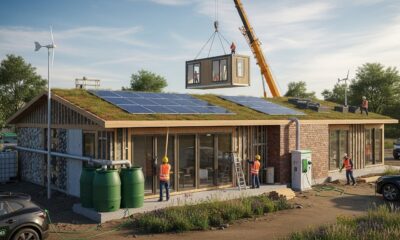Biomimicry, or biomimetics, is starting to gain traction in the building design and construction industry. It’s a concept that draws inspiration from nature. Biomimicry in construction is not just for general design, however, but also for the sourcing of green materials and innovative building techniques.
Modern architecture often uses natural elements to create environmentally friendly buildings. The use of more natural lighting or well-placed fauna, for example, helps to spruce up the inside of an otherwise dreary workplace. We do the same within our homes, hoping that more natural elements will make our interiors both healthier and more welcoming.
Thanks to newer and more innovative construction concepts, our ability to design buildings with natural benefits is better than ever. Now, we can create structures that are sustainable, beautiful and support the natural environment around them.
What Is Biomimetics?
Biomimicry refers to a human-made process, device, substance or system that mirrors nature. There is no right or wrong way to incorporate natural elements as a part of biomimicry. This means there’s a lot of room to experiment in the construction industry.
Essentially, nature serves as the core focus or inspiration for a particular design. For example, architects could design a structure with the honeycomb structure of a bee nest or plan for building ventilation that resembles the tunnel-work within a termite colony. Construction professionals know the honeycomb structure to be naturally stable. Therefore, it’s a wise choice for builders to copy this technique from the natural world.
In another example, new builds across the world are using biomimicry to create stronger roof and building supports. Many architects have begun using tree-like structures within their designs. These look remarkably like branches and offer incredible durability. Westfield London, one of Europe’s largest shopping centers, employs precisely this style of design.
Biomimicry isn’t just making structures appear to look like nature. It can also refer to building products that are strengthened through natural processes. For example, plywood can now be manufactured with an amino acid produced by the blue mussel mollusk. The result is a material free of toxic volatile organic compounds, or VOCs.
Biomimicry in Construction: What Are the Benefits?
Biomimicry has both aesthetic and environmental benefits. For one, the technique produces beautiful manmade structures. Tree-like supports and other natural aesthetics look stylish and functional even when built using traditional materials.
Biomimicry can also, however, create a much more efficient and environmentally sound structure. The environmental impact can be exponentially increased when buildings are constructed using natural materials such as bio-concrete. Bio-concrete is self-healing, vastly increasing the effectiveness of any design.
It’s not always just about improving the quality of the indoor experience or reducing a property’s footprint, either. Builders can also use biomimicry to support nature, helping our structures create a meaningful impact for surrounding wildlife.
Turtle glass is a perfect example of this in the real world. It’s a unique form of glass used within coastal homes. The material has been tinted to reduce light projection. That is because artificial lighting can direct young sea turtles away from the ocean, costing them their lives.
Biomimicry Is a Natural Choice for Building Design
In construction, especially, green initiatives have become more of a priority in recent years. Building projects become much more sustainable when they involve biomimetics at a foundational level.
Ultimately, biomimicry in construction helps reduce the direct impact a structure has on the environment. It also improves the quality of life for the people and animals surrounding these buildings. It’s an incredibly promising form of modern design and construction, and it’s inspiring to see many of today’s most prominent developers and architects incorporating the concept.


 Environment10 months ago
Environment10 months agoAre Polymer Banknotes: an Eco-Friendly Trend or a Groundswell?

 Environment11 months ago
Environment11 months agoEco-Friendly Home Improvements: Top 7 Upgrades for 2025

 Features9 months ago
Features9 months agoEco-Friendly Cryptocurrencies: Sustainable Investment Choices

 Features10 months ago
Features10 months agoEco-Friendly Crypto Traders Must Find the Right Exchange






























